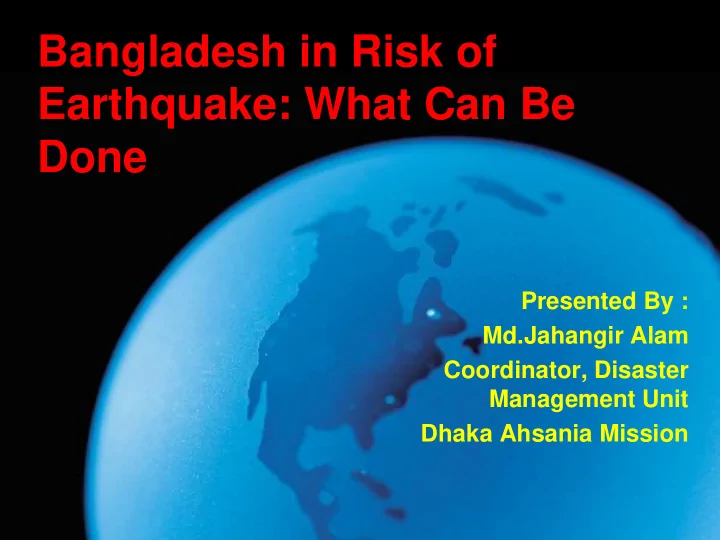

Bangladesh in Risk of Earthquake: What Can Be Done Presented By : Md.Jahangir Alam Coordinator, Disaster Management Unit Dhaka Ahsania Mission
What are Earthquakes? • The shaking /ground vibration caused by the sudden/abrupt release of energy • Usually associated with faulting or breaking of rocks • Continuing adjustment of position results in aftershocksw 2
Richter’s Scale & Measuring Earthquakes • Earthquakes are recorded by a “Seismograph” it draws graphs called “Seismograms” and represents the propagating waves. • The Richter scale is a scale that designs a number to earthquakes for quantify the energy released. 3
Measurement of Magnitude Magnitude Effects Don’t Fell 3.5 or Less 3.5 – 5.4 Cause Minor Damage 5.5 – 6.0 Causing Damage to Building 6.1 – 6.9 Cause Several Damages 7.0 – 7.9 Cause Serious Damages 8.0 or More Total Destruction 4
5
Different types of plates movement 6
The Focus and Epicenter of an Earthquake • The point within Earth where faulting begins is the focus, or hypocenter • The point directly above the focus on the surface is the epicenter
What are Seismic Waves? Response of material to the arrival of energy fronts released by rupture • Two types: – Body waves • P and S – Surface waves • R and L
Body Waves: P and S waves Body waves - P or primary waves • fastest waves • travel through solids, liquids, or gases • compressional wave, material movement is in the same direction as wave movement – S or secondary waves • slower than P waves • travel through solids only • shear waves - move material perpendicular to wave movement
Surface Waves: R and L waves • Surface Waves – Travel just below or along the ground’s surface – Slower than body waves; rolling and side-to-side movement – Especially damaging to buildings
The Economics and Societal Impacts of EQs • Building collapse • Fire • Tsunami • Ground failure
Can Earthquakes be Predicted? Earthquake Precursors – changes in elevation or tilting of land surface, fluctuations in groundwater levels, magnetic field, electrical resistance of the ground – seismic dilatancy model – seismic gaps
Can Earthquakes be Predicted? Earthquake Prediction Programs – include laboratory and field studies of rocks before, during, and after earthquakes – monitor activity along major faults – produce risk assessments
Can Earthquakes be Controlled? • Graph showing the relationship between the amount of waste injected into wells per month and the average number of Denver earthquakes per month • Some have suggested that pumping fluids into seismic gaps will cause small earthquakes while preventing large ones
Earthquake zones of BD 15
Faults and tectonic contacts of Bangladesh
Population under different earthquake zones
Foundation failure and fault of Dhaka city
Liquefaction hazard of Dhaka city
Subsidence hazard of Dhaka city
Family Readiness • Create a family Earthquake plan • Know the safe spot in each room • Know the danger spots • Decide where your family will reunite if separated • Keep a list of emergency phone numbers • Develop a survival kit for work, car, and home
Home Preparedness • Learn how to shut off gas, water, and electricity • Check chimneys, roofs, and wall foundations for stability • Secure heavy furnishings • Secure water heater and appliances • Keep heavy objects on lower shelves • Maintain emergency food, water, medicine, first aid kit, tools, and clothing
Emergency Supplies • First Aid supplies Band-Aids antibiotic ointment latex gloves cold/hot packs ace bandages arm sling Tylenol or Advil diarrhea medication • Equipment work gloves shovel tents sleeping bags ready to eat foods clothing radio, flashlights CASH
During an Earthquake • Stay away from windows, bookcases, file cabinets, heavy mirrors, and other heavy objects that could fall • Duck under a desk or sturdy table • Watch for falling plaster or ceiling tiles • Stay undercover until the shaking stops, and hold onto your cover • If the desk or table you are under moves… move with it • If in your car, stop, but not on a bridge, or under trees or a power line • If outside, stay outside, and move to an area clear of overhead trees, power lines, or objects that could fall from a structure • Don’t forget about aftershocks
After The Earthquake • Be prepared for aftershocks, plan for cover when they occur • Check for injuries, give first aid as necessary • Remain calm, try to reassure others • Wear shoes to avoid injury from broken glass • Check for fire and take appropriate actions • Check gas, water, and electric lines • Tune to emergency broadcast system on radio
26
Recommend
More recommend